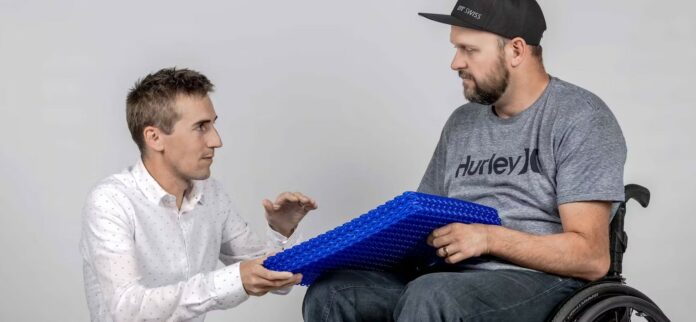Wheelchair users sometimes have to contend with health issues such as pressure injuries like pressure ulcers, also known as decubitus ulcers or bedsores. These occur as a result of long-term pressure on localized areas of skin causing chronic inflammation, which is difficult to manage and can be painful and costly to treat.
To address this issue, CSEM – public-private, non-profit Swiss technology innovation center – joined forces with the Swiss Paraplegic Foundation (SPS) to develop a custom 3D-printed medical-grade cushion for wheelchairs.
So, how can a simple object like cushion address the aforementioned issues?
Compared to traditional air-filled orthopedic cushion, this cushion is breathable, washable, and digitally customizable. And, crucially it could help enhance the quality of life of wheelchair users by helping to prevent pressure injuries, the experts from CSEM explain.
This solution is the result of a joint project between CSEM and SPS that aims to explore the potential of “open-cell” 3D printing.
“Our printers give us the ability to produce objects with an open-cell structure. The open-cell characteristics mean that the resulting printed structures are, amongst other things, exceptionally good at distributing and thereby relieving pressure, and they are very flexible”, Christoph Joder, who works at CSEM, explains.
While the first prototype was quite heavy and took hours to 3D print, selective adjustments to the structure can enable to print a custom made product and address these issues.
CSEM originally developed this technique for a project with the Paul Scherrer Institute (PSI) . “However, we were at a lunch presentation, expounding the benefits of the open-cell structure to an audience of SPS employees, when one of the participants spoke up,” recalls Joder. “This particular individual happened to be a research associate with the SPS and also a person who uses a wheelchair. They saw the potential in the 3D print technology immediately. They asked CSEM’s team whether it would be possible to use the 3D printer to make open-cell seat cushions.”
Custom-made support cushions and seat cushions play an important role in preventing pressure injuries, and related health issues in individuals who require them. However, until now the manufacturing process has been extremely laborious and expensive, with cushions being made individually by hand. Additionally, cleaning them can be challenging, which makes them less sanitary.
Not only are 3D printed cushions are easy to wash, but the traceability of changes is hugely valuable from a regulatory point of view.
The next step for CSEM is now to look-out for a transfer partner to commercialize and further customize this product.
Remember, you can post free of charge job opportunities in the AM Industry on 3D ADEPT Media or look for a job via our job board. Make sure to follow us on our social networks and subscribe to our weekly newsletter : Facebook, Twitter, LinkedIn & Instagram ! If you want to be featured in the next issue of our digital magazine or if you hear a story that needs to be heard, make sure to send it to contact@3dadept.com.






